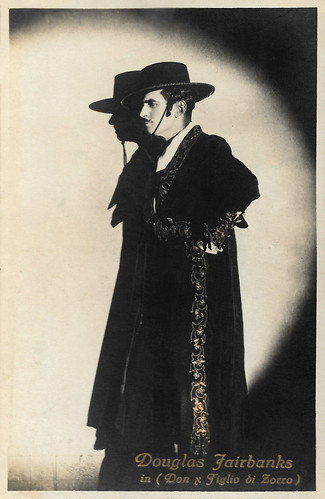
Italian postcard by G.B. Falci, Editore, Milano, no. 452. Douglas Fairbanks in Don Q Son of Zorro (Donald Crisp, 1925).
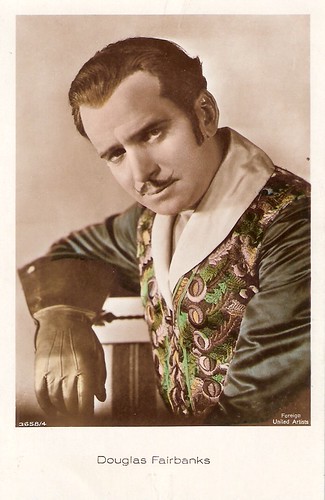
German postcard by Ross Verlag Foreign, no. 3658/4, 1928-1929. Photo: United Artists. Douglas Fairbanks is wearing the outfit from Don Q, Son of Zorro (Donald Crisp, 1925).

French postcard by Les Presses de Belville, Paris. Photo: Walt Disney Productions, 1964. Guy Williams in the TV series Zorro (1957-1959).
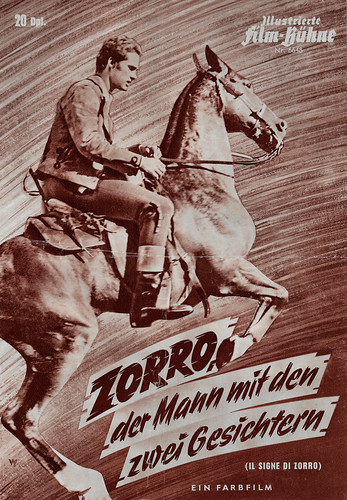
West German flyer by Illustrierte Film-Bühne, no. 6648. Sean Flynn in Il segno di Zorro/Sign of Zorro (Mario Caiano, 1963). The German title was Zorro, der Mann mit den zwei Gesichten.

French postcard by Sonis, no. C. 899. Photo: Zorro Productions / Tristar Pictures. Antonio Banderas in The Mask of Zorro (Martin Campbell, 1998).

Taiwanese postcard by Cool Card. Image: film poster of Antonio Banderas and Catherine Zeta-Jones in The Legend of Zorro (Martin Campbell, 2005).
A genre-defining swashbuckler adventure
Zorro debuted in Johnston McCulley's novel 'The Curse of Capistrano', serialized in five parts between 9 August and 6 September 1919, in the pulp magazine All-Story Weekly. The story was originally meant as a standalone tale, and at the denouement, Zorro's true identity is revealed to all. Zorro is the secret identity of Don Diego de la Vega.
In McCulley's story, Zorro has a high bounty on his head but is too skilled and cunning for the bumbling authorities to catch, and he also delights in publicly humiliating them. Because of this, the townspeople started calling him "El Zorro" due to his fox-like cunning and charm. He is a former university student, newly recalled by his father, Don Alejandro de la Vega, from Madrid to his home outside El Pueblo de Nuestra Señora Reina de los Angeles sobre El Rio Porciuncula, later shortened to Los Angeles.
Then the town was still part of Mexican California (1821–1848), after its independence from Spain. The dashing black-clad masked outlaw defends the people of the land against tyrannical officials and other villains. Not only is he too cunning and fox-like for the bumbling authorities to catch, but he delights in publicly humiliating them. McCulley did not intend to write further stories about Zorro, but the new medium film changed things.
The following year, American actor Douglas Fairbanks had the inspiration of staging a new type of adventure costume picture, a genre that was then out of favour with the public. Fairbanks had been a comic in his previous films. On their honeymoon, Fairbanks and Mary Pickford selected 'The Curse of Capistrano' as the inaugural picture for their new studio, United Artists, beginning the character's cinematic tradition. In his film The Mark of Zorro (Fred Niblo, 1920), Fairbanks combined his appealing screen persona with the new adventurous costume element. This genre-defining Swashbuckler adventure was the first film version of Zorro.
The Mark of Zorro was a smash success and parlayed Douglas Fairbanks into the rank of superstar. Due to its success, McCulley's novel was republished, also titled 'The Mark of Zorro'. In response to public demand fueled by the film, McCulley wrote more than sixty more Zorro stories, beginning in 1922 with 'The Further Adventures of Zorro', which was also serialized in Argosy All-Story Weekly. For the remainder of his career in silent films, Douglas Fairbanks continued to produce and star in ever more elaborate, impressive costume films, such as The Three Musketeers (Fred Niblo, 1921), Robin Hood (Allan Dwan, 1922) and The Thief of Bagdad (Raoul Walsh, 1924). And in 1925, Douglas Fairbanks made a Zorro sequel, Don Q Son of Zorro (Donald Crisp, 1925).

German postcard by Ross Verlag, no. 3658/1, 1928-1929. Photo: United Artists. Douglas Fairbanks and Juliette Belanger in Don Q Son of Zorro (Donald Crisp, 1925).

German postcard by Ross Verlag, no. 3658/2, 1928-1929. Photo: United Artists. Douglas Fairbanks in Don Q, Son of Zorro (Donald Crisp, 1925).

Austrian postcard by Iris Verlag, no. 5205. Photo: United Artists. Mary Astor and Douglas Fairbanks in Don Q Son of Zorro (Donald Crisp, 1925).

French postcard by A.N., Paris, in the Les Vedettes du Cinéma series, no. 171. Photo: United Artists. Douglas Fairbanks in Don Q, Son of Zorro (Donald Crisp, 1925).
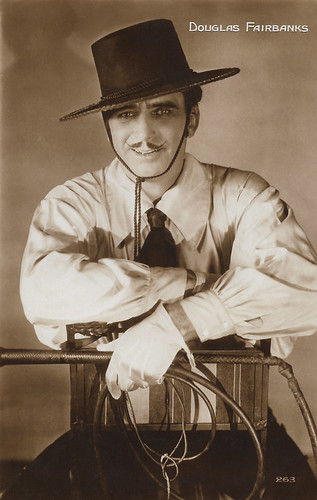
French postcard by Editions Cinémagazine, no. 263. Photo: Fairbanks in his outfit for Don Q Son of Zorro (Donald Crisp, 1925).

Dutch poster by Frans Bosen for Don Q Son of Zorro (Donald Crisp, 1925) starring Douglas Fairbanks.
Foppish dandy by day and masked swordsman by night
In the 1930s and 1940s, Johnston McCulley wrote dozens more Zorro stories for various magazines, including Argosy and West. Several film versions were made during this period including The Bold Caballero (Wells Root, 1936) starring Robert Livingstone and the Republic serials Zorro Rides Again (William Witney, John English, 1937) with John Carroll and Zorro's Fighting Legion (William Witney, John English, 1939) with Reed Hadley. The best-known film version was The Mark of Zorro (Rouben Mamoulian, 1940) starring Tyrone Power.
Walt Disney produced a now classic American half-hour television series Zorro, which ran from October 1957 to June 1959, with a total of 78 episodes. Guy Williams is Don Diego who plays the foppish dandy by day and the masked swordsman Zorro who slashes 'Z's everywhere by night. His horses (black and white) are Tornado and Phantom. Although the series was very popular, especially with a young audience, it had to be discontinued after its second season. This was due to a financial disagreement between Disney and the network that broadcast the series. Author McCulley died in 1958, just as Zorro was at the height of his popularity thanks to the Disney series.
Disney also released two feature films with Guy Williams, The Sign of Zorro (Lewis R. Foster, Norman Foster, 1958) and Zorro, the Avenger (Charles Barton, 1959) which were episode compilations. There were also four one-hour follow-ups on the Walt Disney anthology television series in the 1960–1961 TV season. During the 1960s various Zorro films were produced in Spain and Italy. These included La venganza del Zorro/Zorro the Avenger (Joaquín Luis Romero Marchent, 1962) with Frank Latimore, Il segno di Zorro/Duel at the Rio Grande (Mario Caiano, 1963) with Sean Flynn, Zorro e i tre moschettieri/Zorro and the Three Musketeers (Luigi Capuano, 1963), with Gordon Scott, I nipoti di Zorro/The Nephews of Zorro ( Marcello Ciorciolini, 1968) starring the comic duo Franco and Ciccio and Dean Reed and El Zorro justiciero/The Avenger, Zorro (Rafael Romero Marchent, 1969) starring Fabio Testi.
Hollywood became interested again in the dashing black-clad masked swordsman and produced the TV film The Mark of Zorro (Don McDougall, 1974) starring Frank Langella and also with Ricardo Montalban, Gilbert Roland and Yvonne De Carlo. It was also a backdoor pilot for a television series on which ABC-TV declined to pick up the option. More successful were the Italian Zorro Westerns Ah sì? E io lo dico a Zzzzorro!/Mark of Zorro (Luca Damiano, 1975) with George Hilton and Zorro (Duccio Tessari, 1975) starring Alain Delon. After the Mexican Western, La gran aventura del Zorro/The Great Adventure of Zorro (Raúl de Anda, 1976) with Rodolfo de Anda and a massive hit in Mexican Cinema, Hollywood came with a satire, Zorro, the Gay Blade (Peter Medak, 1981) with George Hamilton.
Nearly 20 years later, Zorro was finally reanimated in the Oscar-nominated American Swashbuckler The Mask of Zorro (Martin Campbell, 1998). The lead roles are played by Anthony Hopkins as an aged Don Diego de la Vega and Antonio Banderas as Alejandro Murrieta, a misfit outlaw/cowboy who is groomed to become the next Zorro, with Alejandro eventually marrying Diego's daughter Elena (Catherine Zeta-Jones). A sequel to the film came in 2005 with The Legend of Zorro (Martin Campbell, 2005). Antonio Banderas and Catherine Zeta-Jones reprise their roles as the titular hero and his spouse, Elena, and Rufus Sewell stars as the villain, Count Armand. In 2005, Isabel Allende also wrote an (obviously fictional) life story of Zorro, 'El Zorro'. She wrote the book on behalf of Zorro Productions, Inc, the Californian company that has owned the rights to Zorro since 1986.
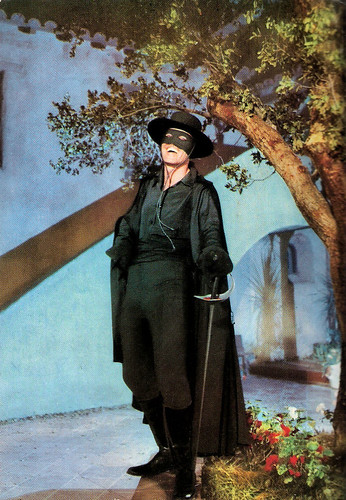
French postcard by Les Presses de Belville, Paris, no. 109. Photo: Walt Disney Productions, 1964. Guy Williams in Zorro (1957-1959).

French postcard by Les Presses de Belville, Paris, no. 110. Photo: Walt Disney Productions, 1964. Guy Williams in Zorro (1957-1959).
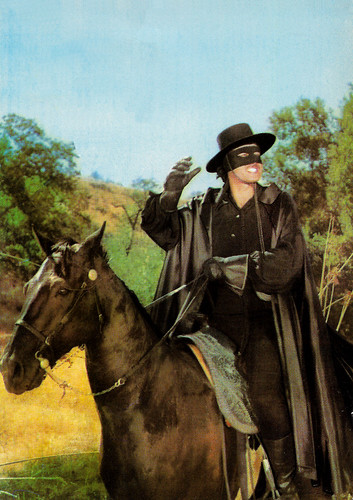
French postcard by Les Presses de Belville, Paris. Photo: Walt Disney Productions, 1964. Guy Williams in Zorro (1957-1959).
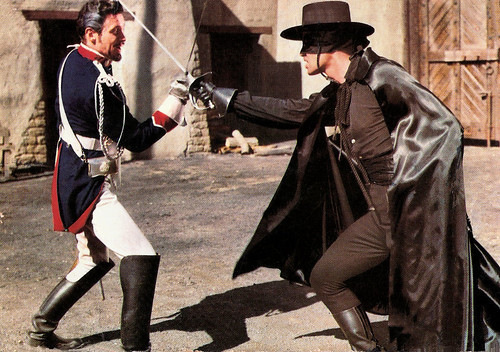
French postcard by Les Presses de Belville, Paris. Photo: Walt Disney Productions, 1964. Guy Williams in Zorro (1957-1959).

French postcard by Les Presses de Belville, Paris. Photo: Walt Disney Productions, 1964.

German postcard by Memory Cards, no. 495. Photo: Antonio Banderas and Catherine Zeta-Jones in The Mask of Zorro (Martin Campbell, 1998).

German postcard by Memory Cards, no. 496. Photo: Antonio Banderas and Anthony Hopkins in The Mask of Zorro (Martin Campbell, 1998).

German postcard by Memory Cards, no. 497. Photo: Antonio Banderas in The Mask of Zorro (Martin Campbell, 1998).
Sources: Wikipedia (Dutch and English), and IMDb.
No comments:
Post a Comment